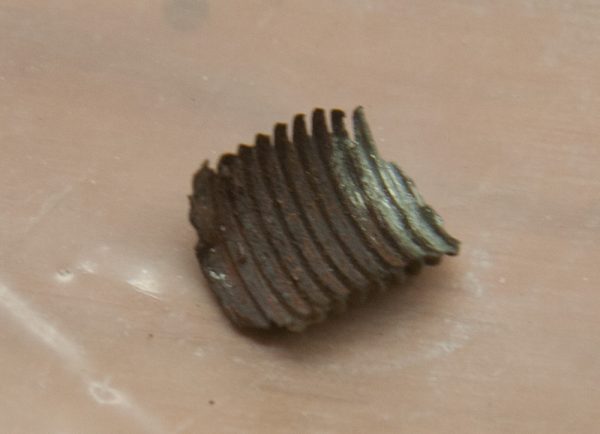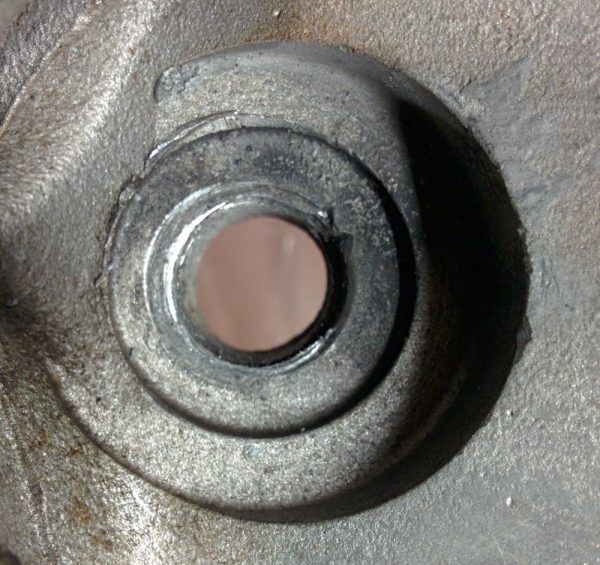After mounting the stainless steel intake runners, I did a few test runs to adjust the AeroCarb needle. I’m not going to get into the results from those runs right now since they’re incomplete, except to say that it seems like when you plot the EGTs vs fuel flow, it doesn’t matter how you adjust the needle. This is indeed exactly what you’d expect, since the needle setting just changes what fuel flows you’ll get at different mixture settings. This is good, because that means we can make sure we get data on the EGTs for different fuel flows, decide what fuel flow gives the desired temperature drop from peak EGTs, and then adjust the needle to get that fuel flow at full rich.
However, as I was making a test run, the engine surged when I pulled back from full throttle, died, and wouldn’t restart. It seemed like it was lean, so I immediately thought it had sprung a leak somewhere in the intake system. I couldn’t find it, though, so I took everything apart again, took the plenum home, and pressurized it. No problem.
Eventually I realized I had run out of fuel. Classic… It turns out the fuel meter is really poorly calibrated down at the bottom, such that it went from saying I had 7 liters to 1 liter in less than a minute. I looked at it when I started the run, concluded I had plenty for what I wanted to do, and didn’t look again. Well, now I know that…
As I was trying to figure out why it didn’t run, I turned the engine over by hand several times and noticed a hissing noise coming somewhere from the area of the #4 intake. I couldn’t quite hear if it came from the intake itself, meaning the intake valve was very leaky, or the head gasket, so I brought my mechanic’s stethoscope down to listen.
Turns out it was one of the #4 spark plugs that was not sealing, and when I attempted to tighten it, the thread stripped. Great. I removed the spark plug and turned the engine over again. It was still hissing, so I also found a leaky, stripped spark plug on the #2 cylinder, and then one on the #1.
So, three stripped spark plug threads. No big deal. I remember when we reassembled the motor after Bob’s valve job in May that I thought at least one of the spark plugs felt fishy when I tightened, so this was not a big surprise.
It’s also apparently common enough that the Sonex Builders Foundation has an Aerovee spark plug Time-sert repair kit that they will lend you, so you don’t have to buy the $160 kit and use it once. A great service provided by Mike Smith at the Sonex Foundation (who had to repair his spark plugs…)

The IKEA airplane mechanic’s umbrella came in handy. Standing out on that ramp in the Sun a whole day is just a killer. The umbrella made it bearable, and it only blew over once.
After spending all of Sunday down on the ramp (in the shade!) taking the heads off and bringing them home, I removed all the other spark plugs and discovered that fully 5 of the 8 spark plug threads have already been repaired!
How this came about is a bit of a mystery. Builder and co-owner Bob has no memory of ever repairing a spark plug. The heads have been rebuilt twice by the local VW shop, but those bills don’t say anything about repairing spark plugs. And while some heads came from Sonex already with inserts in place, our heads are not in that S/N range.
Some of the repairs look like Time-sert style inserts and appear decent, but a couple are absolutely terrible.

This partial, rusty insert was sitting in one of the spark plug holes. The hole itself appears to be oval, so it’s as if someone tried to save it by jamming half a thread insert in there!
The partial insert above, and a really bad Helicoil, were also not square with the seat, so the spark plug washer appears to not have been making contact across the entire face.

It’s obvious that the washer on this spark plug has not been making full contact with the seat, so the repaired hole must not be square to the seat. No wonder it leaked.
Le sigh. What the hell kind of hack job is this? On an airplane engine no less! I came across the accident report of a fatal accident in a Sonex where the engine lost power after takeoff and the pilot attempted to turn back to the airport and spun in. Cause of power loss: a botched spark plug repair on the Aerovee engine. This is not some abstract theoretical thing!
It’s unclear whether these previously-repaired holes are repairable. I’ll give it a try, but if it turns out to be sketchy, we’ll probably just get a new pair of heads. Luckily parts for these VW engines are fairly cheap (extremely cheap by aviation standards!) and replacement heads are only $325 each (and rumor has it that the current manufacturer used by Sonex has much higher quality workmanship than the previous heads, so we’d probably end up with better heads, too.) But it’s not like we’re itching to waste upwards of $700 on that, there are other things that need fixing, too…
That’s the current situation. The Time-sert kit should hopefully show up in the mail tomorrow and then we’ll see what happens. I’m really hoping we’ll have the engine together so we at least can taxi the plane over and display it at the Annual Hilo Airport Aviation Day and Fly-In on 10/21. More later.
I’m not sure but it could be that re-Time-Sert-ing a spark plug hole (or holes) might be better and more effectively done with the Big-Sert product.
On another note, it’s a walk down memory lane reading your thoughts/findings of aircraft repairs that could easily end up constituting a link in the error-chain description in a future NTSB accident report. Back in ’99 I was trained as an Air Force Safety and Crash Investigation Officer. It was a very eye-opening experience revisiting old investigations in which a little things (like your spark plug threads) ended up playing large parts.
Indeed, but they only seem to make Big-serts for M14 spark plugs. They make “normal” big-serts for M14x1.25, but I think the difference from the spark plug ones is that the normal ones don’t re-cut the seat, so there’s no guarantee that the seat will be aligned with the hole. Since that already seems to be the problem, I’m not inclined to buy the $120 Big-sert kit just to see if it will work.
Pingback: Spark plug thread repair – Patrik's projects